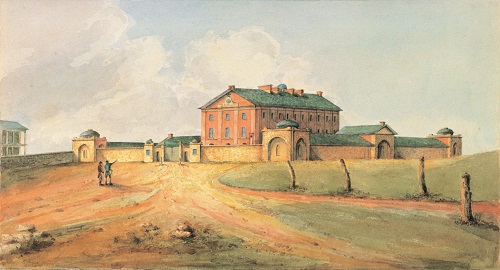William was by trade a butcher (2) but at age 20 he was convicted at the Old Bailey in London for housebreaking and stealing goods valued over £168 (1) – a fortune at the time. He was sentenced to death commuted to 7 years in the colony and arrived in Australia on the Hillsborough, sometimes referred to as the “Fever Ship” since some ninety-five of the three hundred convicts aboard died from typhoid fever. (2)
Reaching Sydney in 1799, Hutchinson was again convicted of theft after stealing from the government stores in Sydney and was transported to the penal settlement on Norfolk Island. (2)
William Hutchinson soon gained employment in the administration of the settlement, becoming an overseer of government livestock. In June 1801, he married his first wife Mary Cooper (also known as Mary Chapman), a convict and together they had eight children, six of them born on Norfolk Island. (2)
In June 1803 he was appointed acting superintendent of convicts on the island, and in 1805 he officially became an emancipist. By 1809 he was made a superintendent and used his position to make a handsome trade selling pork to the government. He used the proceeds to acquire significant landholdings on the island. (2)
Incidentally, John Jobbins (instigator of Dora Dora massacre) was a butcher by trade and when a free man went back to butchering and held contracts to supply meat to the military. Jobbins became an immensely wealthy man as did William Hutchinson which suggests supplying meat to the government was a very lucrative business. (3)
When Hutchinson arrived back in Sydney in 1814 he was appointed superintendent of convicts and public works and in this position, he exercised much influence in assigning convicts to the public, many of them wealthy and influential. (2) When a new shipment of convicts arrived at the wharf there would have been great eagerness to read the list of trades on board and put in an application for any that suited your needs. The convict lists of the era show a wide variety of skills such as butlers, milkmaids, cooks and shoemakers, silver platers, nail makers, stonemasons and coopers. William Hutchinson’s position in assigning convicts to the public would have given him enormous power. It is not surprising he soon became a close associate and confidant of Governor Lachlan Macquarie.
Part of William Hutchinson’s duties was to receive the convicts’ money and property when they arrived which, with other deposits, he at times invested to his own benefit. He was a considerable landowner and pastoralist, with properties near Moss Vale, Bargo, Mittagong, Sutton Forest, Bringelly and Bong Bong. (4)
William Hutchinson also had land on the Murrumbidgee River and at some time his cattle strayed from the station. One of his stockmen carved a notice on a tree alerting the public. it read, “Good people all as you pass by. Should you see any cattle branded W.H, on the thigh. Please herd them round for Gundagai”. The poet’s name was Porta-down Bob. (5)
On 14th January 1824 Hutchinson’s daughter, Elizabeth aged 17, married William Bowman of Sutton Forrest. (1)
William Bowman was a wheelwright and had an inn on the Wingecarribee River near Bong Bong. (6)
1838–William Bowman and his father–in–law William Hutchinson took thousands of acres of land from the west bank of the Coliban River to the Mount Alexander Ranges. Later broken up into two runs: Sutton Grange and Stratford Lodge. (7)
There is no suggestion that Hutchinson ever lived at Stratford Lodge but there is evidence that William Bowman lived for a time a the adjoining station of Mount Alexander. Bowman is mentioned in Victorian Records vol 2A when both he and his neighbour Yaldwin have their sheep taken away by Blacks in 1838 in an incident that led to the Waterloo Plains massacre. (8)
In 1825 William Hutchinson married again, his second wife being the widow of another successful emancipist, originally Jane Roberts, who was transported for seven years and arrived in the Glatton in 1803. She soon left him but two of the sons of her first marriage wed two of Hutchinson’s daughters. (4)
William Hutchinson died on 26 July 1846, leaving goods and money of just under £20.000. He had properties with houses in George, Pitt, King, Campbell and Fort Streets, Sydney. He had property at Moss Vale, Mittagong, Sutton Forrest, at South Creek Hutchinson Farm 1,700 acres, Stoney Range Bringelly 350 acres, Golden Grove Farm Bong Bong 4,000 acres, Bargo 50 acres, Chippendale Estate and Umpleby’s property in Melbourne. He left houses to his daughters and made bequests of £100 to the Sydney Infirmary and the NSW Benevolent Society. He bequeathed legacies of £1,000 to his sons William and Richard and £500 each to nine of his grandchildren. He also left legacies to Elizabeth Amelia Hart and Alfred Francis Hart of Windsor of £500 and £300. (2)
At his death, his estate was worth £220,000, or about $1.77 billion in 2004 value. On this valuation, in 2004 William Rubenstein placed Hutchinson at 147th on his list of the two hundred richest Australians of all time. (9)
THE REFERENCES;
(1) Australian.royalty.William-Hutchinson
(2) Published by Granville Historical Society Inc. http://granvillehistorical.org.au/Newsletters/Granville Guardian 2006 October.pdf
(3) See John Jobbins profile on the website
(4) Australian Dictionary of Biography – William Hutchinson
(5) Ogier’s reminiscences of David Reid, http://nla.gov.au/nla.obj-52773898
(6) berrimadistricthistoricalsociety.org.au
(8) https://c21ch.newcastle.edu.au/colonialmassacres/detail.php?r=507
(9) https://en.wikipedia.org/wiki/William_Hutchinson_(superintendent)


